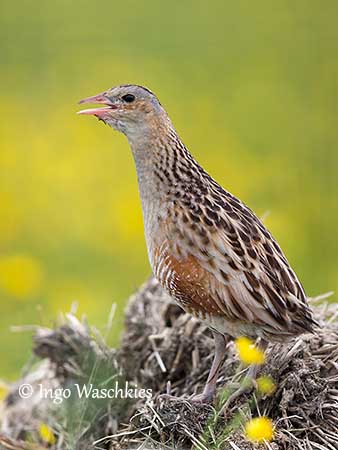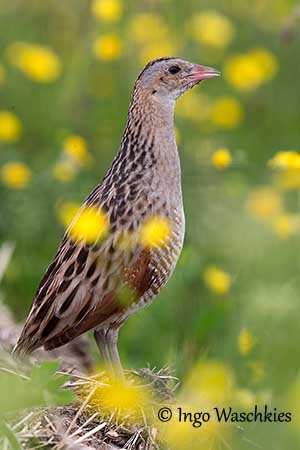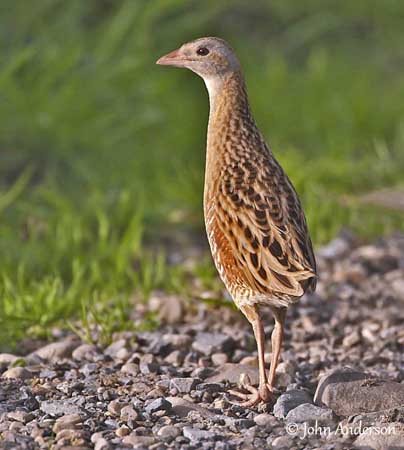
Fr: Râle des genets
All : Wachtelkönig
Esp : Guión de Codornices
Ital : Re di quaglie
Nd: Kwartelkoning
Sd: Kornknarr
Photographer:
John Anderson
John Anderson Photo Galleries
Ingo Waschkies
My bird pictures on Pbase
Text by Nicole Bouglouan
Sources:
HANDBOOK OF THE BIRDS OF THE WORLD Vol 3 by Josep del Hoyo-Andrew Elliott-Jordi Sargatal - Lynx Edicions - ISBN : 8487334202
BIRDS OF AFRICA SOUTH OF THE SAHARA by Ian Sinclair and Peter Ryan - Princeton University Press Princeton and Oxford - ISBN: 0691118159
ROBERTS BIRDS OF SOUTH AFRICA by G. R. Mc Lachlan and R. Liversidge – The Trustees of the John Voelcker Bird Book Fund – ISBN: 0620031182
BIRDS OF THE MIDDLE EAST by R.F. Porter, S. Christensen, P Schiermacker-Ansen C.Helm - ISBN: 0713670169
L’ENCYCLOPEDIE MONDIALE DES OISEAUX - Dr Christopher M. Perrins - BORDAS - ISBN: 2040185607
THE COMPLETE BOOK OF BRITISH BIRDS – Written by “Royal Society for the Protection of Birds” experts - Préface de Magnus Magnusson - Michael Cady- Rob Hume Editors - ISBN: 0749509112
THE HANDBOOK OF BIRD IDENTIFICATION FOR EUROPE AND THE WESTERN PALEARCTIC by Mark Beaman, Steve Madge - C.Helm - ISBN: 0713639601
BirdLife International (BirdLife International)
Corncrake
Crex crex
Gruiforme Order – Rallidae Family
BIOMETRICS:
Length: 27-30 cm
Wingspan: 42-53 cm
Weight: M: 130-210 g – F: 138-158 g
DESCRIPTION:
The Corncrake was formerly more abundant than today, living in its preferred habitats, meadows and grasslands with bushes and scattered trees.
But today, due to repeated cut of grass for agriculture expansion, the suitable habitats favoured by this species are more reduced, making this bird rare and threatened.
The adult has rufous-brown plumage on the upperparts, with blackish-brown feathers edged pale buff, giving scaled pattern. Wing-coverts are chestnut-orange, conspicuous in flight on both upper and underwing.
On the underparts, chin and throat are white, whereas foreneck and upperbreast are pale grey with faint pale brownish scaled pattern. Flanks, belly and vent are barred white and rufous.
On the head, centre of crown and nape are similar to upperparts. There is a grey stripe above the eye, like a broad supercilium joining the hindcrown. We can see a rufous stripe from lores to rear eye and joining the nape. Cheeks are pale grey.
The bill is pink. The eyes are brown. Legs and feet are pale flesh.
Both sexes are similar but the female has often warmer buff upperparts. The grey streak over the eye is narrower and duller. There is less grey on cheeks, neck and breast.

The juvenile resembles adult but it has narrower and paler fringes on upperparts, and upperwing-coverts are less barred. The pale grey tinge of head sides, foreneck and breast is mostly buff-brown. Flanks show less contrasted barring. The eyes are duller. Legs and feet are dark grey.
VOICE: SOUNDS BY XENO-CANTO
The Corncrake gives loud rasping calls during the breeding period. This call is uttered almost continuously night and day. It gave the bird its Latin name “Crex crex”.
This advertising call is heard before to see the bird. This is a far-carrying series of repeated, dry, rasping “crex-crex… crex-crex… crex-crex…”. This song is given only by the male which usually calls from ground or low perch, wall or bush, with head and neck held upwards.
During aggressive or courtship displays, it also gives a “growling-mew” call, similar to the grunting of small pigs. But other sounds such as grunts, whistles, click and quacking notes are heard too.
This species is silent on its wintering ground in Africa.
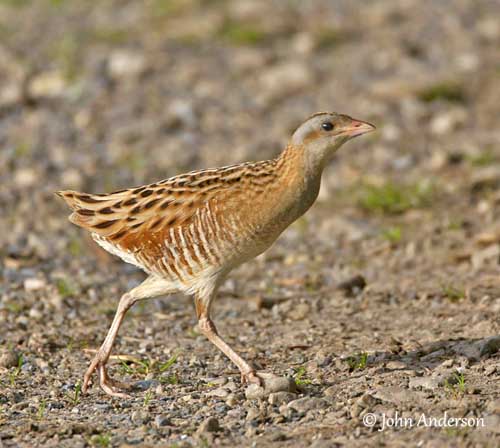
BEHAVIOUR:
The Corncrake feeds on various invertebrates such as earthworms and molluscs, spiders and insects. It also takes small frogs, and occasionally small mammals and birds. It consumes the green parts of plants, seeds of grass and grain. Its diet is similar during the winter in Africa.
It is active at dawn and dusk and after rain. It may run to pursue and catch a more active prey.
It is rarely seen in open, and forages within the shelter of the vegetation, occasionally on grassy tracks and roads in Africa.
It feeds on the ground, taking food from low-growing plants and grass tussocks. It also probes into the leaf-litter with the bill to find invertebrates.
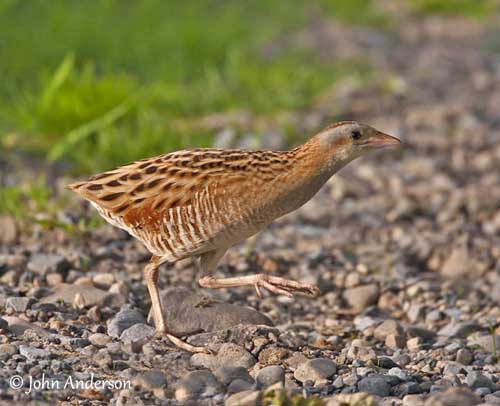
During the breeding season, calls are heard and displays are reported.
The male calls loudly during several hours by day and by night. This advertising call is used to establish the territory, but also against intruders and to attract females. It calls until the start of the laying, and often, only head and neck are visible above the tall grassy vegetation.
The Corncrake may sometimes be polygynous. Other females entering a male’s territory are not regarded as intruders and not chased. Broods of close territory’s neighbours can be associated with several birds but with only one male.
Monogamy occurs too in this species, but polygyny is regular. One male occupies overlapping territories and mates with two or three females, but it does not take part in nesting duties.
The displays of this species are not well known, but usually in Rallidae species, courtship displays enhance the bold flank pattern and the contrasting colours of wing-coverts. Displays are accompanied by calling.
This species nests solitary and the territory is chosen for its abundant food resources.
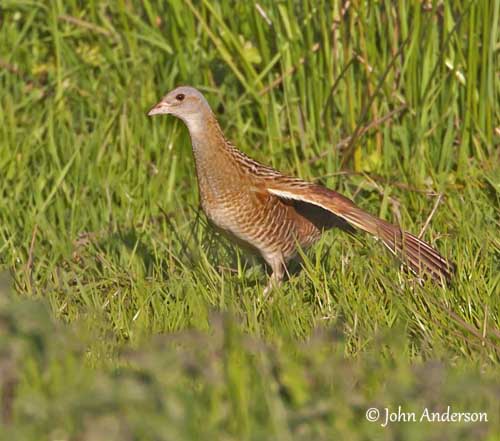
The Corncrake is a long-distance migrant. It migrates at night at low altitude. A high degree of vagrancy is reported, due to birds blown off their road by strong winds.
FLIGHT:
The Corncrake has relatively long wings. When flushed, it flies with whirring wings and dangling legs trailed behind. But although its fly is weak and jerky, it is able to fly fast and for long time during migrations.
REPRODUCTION:
The breeding season occurs between April and August.
The Corncrake nests in grassland, sheltered along hedgerows or near isolated trees, or in bushy areas. The nest is on the ground, concealed in dense vegetation or in tussock. It is a shallow cup made with grass, weeds and brambles. The cup is lined with dead leaves. The surrounding tall grasses are often pulled over the top of the nest like a loose canopy. The female probably builds the nest alone.
She lays 8-12 whitish eggs with brown spots at daily intervals. Larger clutches are laid by two females. She incubates during 16-19 days and hatching is synchronous. The downy chicks are brownish-black with rufous wash on the upperparts. They have pink bill and black legs and feet.
They are fed and cared by the female, sometimes by two adults, probably two females, but this is not very clear. They feed themselves at 3-4 days, and fledge at 34-38 days of age, when able to fly.
This species produces one or two broods per year.
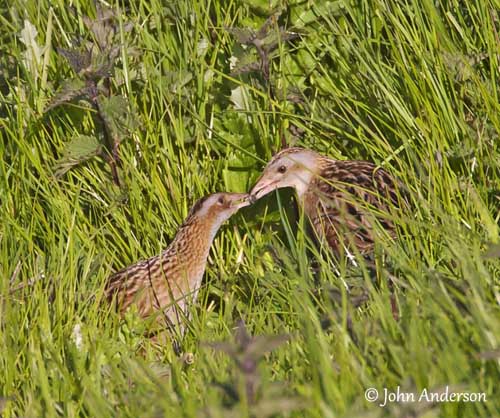
DIET:
The Corncrake feeds on earthworms and molluscs, Isopoda (crustaceans), Diplopoda (millipedes), spiders and several insects’ species such as Coleoptera, Diptera, Orthoptera, Odonata and Hymenoptera. It also takes small frogs, and occasionally small mammals and birds, and seeds of grass and grain.
PROTECTION / THREATS / STATUS:
The Corncrake’s populations suffered important declines since one century, and in several parts of the range, the species is still threatened by agriculture expansion and repeated cut of grass and degradation of the habitat, involving heavy losses of nest, eggs, chicks and even adults.
Since 2002, numbers appear stable with even some increase including in UK. For this reason, the Corncrake has been reclassified as Least Concern by BirdLife International.
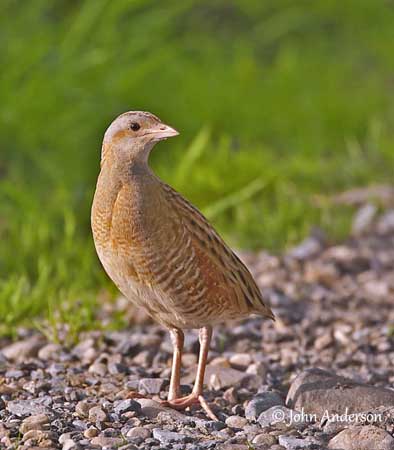
HABITAT:
Unlike most of Rallidae species, the Corncrake favours damp grassland rather than wetland. This species breeds in dry to moist meadows and grasslands such as alpine meadows, marsh fringes and clearings in forest with dense tall grass.
After breeding and on wintering grounds, it can be seen in cereal fields and cultivated areas, and it also moves into vegetation along ditches, roads and dams.
In Africa, it occupies dry grassland and savanna.
This species occurs from sea-level up to 3000 metres of elevation.
RANGE:
The Corncrake breeds in W and NW Europe, from British Islands to NW China and C Siberia. It leaves the breeding grounds in August-September and migrates to Sub-Saharan Africa, in E Zaire and S Tanzania, and to South Africa. It returns to the breeding grounds in April-May.
